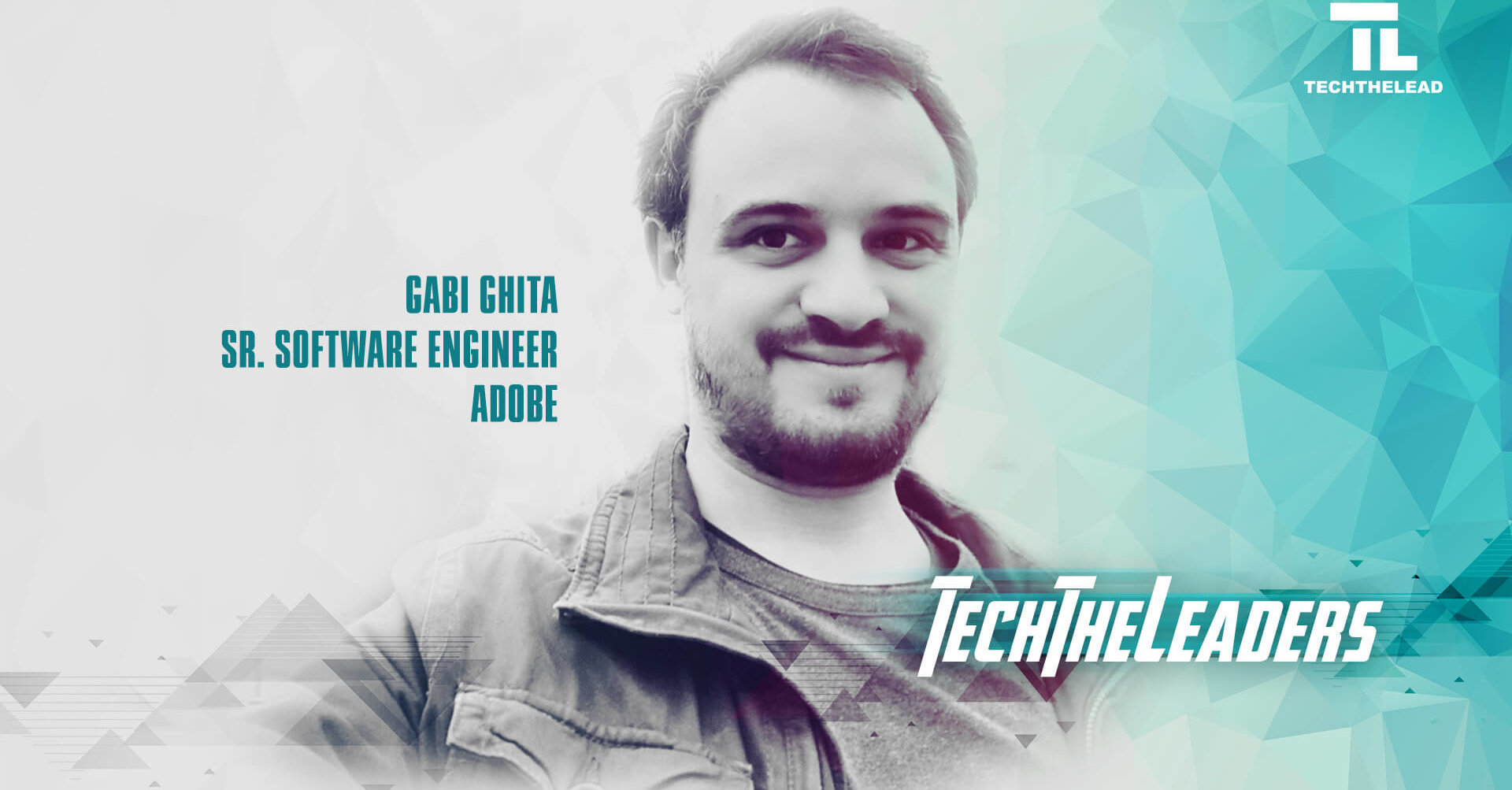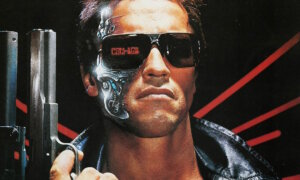Meet Gabi Ghita, one of the minds behind the “New Photoshop AI Update”. A man of many talents, and a creative soul through and through, we asked Gabi to jump-start our TechTheLeaders series.
This is where you’ll get insight and advice from successful people in the field of technology about how they got a coveted job position, what is their workday like (challenges included), but also where they see the tech world going and how they stay true to themselves in these chaotic times.
Programmer, musician, and traveler, Gabi is now a senior software engineer at Adobe. He joined the company in 2019 (shoutout to their First Mile team, of which he’s a proud member!) and for the past year or so he’s been part of a sort of “team of teams” within Adobe, working on the massive new Photoshop feature called Neural Filters.
⇠⇠ PLAYING GUITAR DURING PROGRAMMING BREAKS ⇢⇢
Before that, he contributed to rewriting the “Command+N” dialog for some of the major Creative Cloud apps so that it’s more performant and uses more modern technologies.
In the 12 or so years before Adobe, he worked for a small company that provided enterprise document rendering solutions to other companies.
He learned to play guitar back in high school and has been playing off and on ever since. A few years ago he also started dabbling with learning piano, and even had a band for a few years.
He likes to play all sorts of songs, but on stage, he only ever did Tom Waits tribute shows. When things get back to normal, he might try something new, like a Bob Dylan tribute.
Q1. Beginnings set up the scene for every good plot. What did you want to be when you grew up, and what are you doing now?
I was very fond of computers from early on. Back in the 90s when I was a kid, I used to have this HC-85 computer, which is basically a ZX Spectrum clone, 64KB of RAM (yes, kilobytes), and you could load apps and games from an audio cassette. I had tens of cassettes with dozens of games each and would play the heck out of them.
It also supported the BASIC programming language, so that was the first place I saw and could write real code. But of course, I was a kid, I rarely did any actual coding, but I did attempt to reverse engineer different parts of the games — usually the loading screen, which was often a cool picture I’d want to save and edit somehow, but many games had protection, a crude version of DRM — and so I learned about as much as I could understand at the time.
Later, I borrowed a book on Visual Basic, read it, and wrote a calculator app over the summer. It was fun, but I was more into maths at the time. I had qualified for the national phase of the Mathematics Olympiad so I focused on that (along with guitar and heavy metal, of course) for the better part of high school.
“I WANTED MY CAREER TO BE ABOUT CREATING EXPERIENCES”
Ultimately, I didn’t want to take my chances in life with maths as my only skill, so I started catching up on coding and algorithms and even won 3rd prize at a local computer science contest. I went to University to study computer science and started working in parallel as a junior developer to make ends meet.
Being among the first employees in a small company, I got to grow with it over the years, experimenting with various responsibilities beyond engineering: management, leadership, customer demos, implementations, and even sales to an extent.
Jumping ship to where I am now might sound like a “back to basics” move after all that, but to me, it’s all a deeply creative process at every level, and all that past experience comes together to inform every decision, from how you write your code so that others understand it and can extend it in the future, to how you tailor the user experience so that it’s both powerful and intuitive.
The devil’s always in the details. So, going back to the initial question, I knew I wanted it to be something related to computer science, coding, but I didn’t know exactly what, then over the years it became clear to me that I want my career to be about creating experiences.
Q2. Ten years ago, we needed a few hours to create some of these Photoshop effects, and now the user can preview them in real-time. What changed?
The answer is machine learning. The science behind it evolves at a very rapid pace, but the difference is that now our hardware is fast enough to support it, so we’re seeing more and more ML-driven solutions make their way to the mainstream. And even if your hardware isn’t top-notch, the cloud can pick up the slack.
Internet speeds and cloud infrastructure have both come a long way, so now you can offload that heavy-duty processing to services in the cloud and stream the result over to your machine in real-time — some of our Neural Filters do that.
You might think that AI has been there for a while, ever since we’ve been playing chess or tic-tac-toe with our computers, but those are procedural AIs: you explicitly tell them what to do in every situation, you program that logic step by step: “if X happens, then do Y”.
With machine learning AIs, it’s a different story. You build a neural network (think of it as a virtual “brain”) and then feed it loads and loads of data containing both the inputs and outputs you expect to get.
This process is called “training” and can take a lot of time. Then, after the network is trained, you feed it an input and it gives you the output. You can also continue to feed new data to make it better over time. So it’s a vastly different approach than building a traditional AI, it’s a more black-box method.
“THE CRAFT LIES IN HOW YOU DESIGN THE “BRAIN”, AND THAT’S WHERE ALL THAT SCIENCE COMES IN.”
Most of the “brains” powering Neural Filters are GANs (Generative Adversarial Networks), which are special types of ML frameworks that work very well for image manipulation. They can generate photographs that look very realistic to the human eye. And these ML models are all built by machine learning specialists, actual researchers who print their own papers and patent their work, as well as study the newest papers coming from other ML researchers.
But that’s about as much as my knowledge goes. I was just the architect and main engineer for the front-end, meaning I just built the UI side and the framework required to surface these super-advanced capabilities to the user in an intuitive way.
⇠⇠ TEAMWORK AND CHALLENGES: WHAT TO KEEP IN MIND ⇢⇢
Q3. What is the biggest hurdle your team encountered during this development cycle and, was it fixed by a Eureka moment, or is there no such thing in software development?
There definitely is such a thing, but usually not as big as to turn a whole project on its head. Epiphanies do happen, but at lower levels, and it’s a different experience from person to person. For me, it works like this: when I try to build something, I try to think of the best way to organize my code so that it best reflects the behavior that I’m trying to model.
Of course, there are well-known patterns for this sort of thing, literally called “design patterns”, but that doesn’t mean there’s no creativity involved.
Every scenario is different, either because it has to cater to a different type of user, or it has to work within a certain technological framework that’s already there, or it has to support adding on certain other features in the long run, so these patterns are really just the starting point, a toolbox you can reach to for inspiration.
You still have to figure out how to meet your particular criteria without giving yourself or some unlucky colleague the pain of having to rewrite your code from scratch a year from now. So when all of that stuff clicks into place and you see the solution clearly, there’s your Eureka moment.
Q4. Knowing what you know now about the capabilities of AI, programming, cloud computing, and all technological advancements that humankind achieved lately, what do you think is the next big step in tech?
Oh wow, it’s hard to say. There’s so much happening and it’s all evolving so fast, but I don’t want to make any predictions. We’ll certainly see this tech leveraged more and more and it will have a bigger and bigger impact on our lives. I think it’s up to us to make sure that, when the time comes, that impact will be positive.
⇠⇠ HOW TO STAY TRUE TO YOURSELF ⇢⇢
Q5. What is your ultimate pet peeve that most people don’t seem to mind?
Wow, I don’t know, I’ve never ranked them, haha. Let’s see, logical fallacies maybe? That’s pretty common. You see people drawing universal conclusions based on some anecdotal evidence. That really gets under my skin, but most folks don’t seem to mind.
Q6. What is, in your opinion, the definition of a decent person?
I think decency mostly comes from honesty. Staying true to your core values while also being willing to change your beliefs based on new evidence. I also think we need to actively look toward helping others.
Neither of us made it to where we are without the help of others, so if your life is good right now, don’t forget to be grateful for the help you got along the way. In that sense, it’s fortunate that the better off you are, the more opportunities you get to help others.
After all, we live in a society, so let’s pay it forward.
Q7. In a utopia, in your opinion, what should we use instead of money and why?
I’m not sure money itself is the issue. I think you’ll always need a sort of universal metric by which to quantify the value of things. I don’t think people in a perfect world would necessarily need to get rid of money. The goal should be to ensure a decent standard of living for everyone.
Now whether that’s some form of universal income or universal basic necessities that are being provided directly to every citizen with no strings attached, what would make this hypothetical society ideal is that everybody would get a shot at pursuing their passions without those choices being a threat to their livelihood because they don’t pay as well or become obsolete over time.
This would also get people to be more supportive of automation and technological progress, so it’s a win-win.
“MONEY ITSELF IS NOT THE ISSUE, BUT THE STRINGS ATTACHED”
Q8. In the world of fast internet, 5-second reviews, and clips, how do you slow down?
Really leaning into the hard questions now! Well, I try to stay off social media feeds (you know the kind, with infinite scrolling) as much as possible. That stuff is really addictive and just feeds into a sort of fear of missing out on things. Instead, I try to listen to music or podcasts, things that don’t lock you into one activity, so I would leave them playing in the background while I work or do other things.
Q9. You are in the middle of the woods, with only the clothes on your back, stranded. How do you survive?
If I’m being totally honest, I probably won’t, haha. That’s probably my biggest weakness.
And now that you’ve reached the end, a piece of advice from Gabi on how to live in this mad, mad world:
“What can I say about the world? Doug Stanhope called it a “rental car”, implying that we should enjoy ourselves while we’re in it, but don’t leave a mess for the next guy. Similarly, Hunter S. Thompson said: “Buy the ticket, take the ride” because in the end, that’s all it is. And Tom Waits once said: “I’d rather have a free bottle in front of me than a prefrontal lobotomy” and I think you’ll find it’s very hard to disagree with that statement. Seriously though, Tom’s great. Go check him out.”
Follow TechTheLead on Google News to get the news first.





























